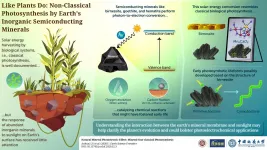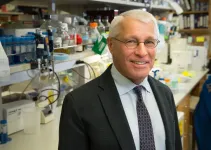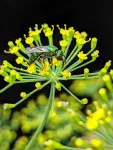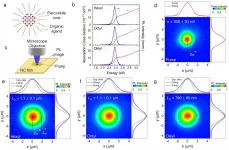(Press-News.org) Photosynthesis, the process by which plants and other organisms convert sunlight into chemical energy, has been a major player during the evolution of life and our planet's atmosphere. Although most of the ins and outs of photosynthesis are understood, how the necessary mechanisms evolved is still a topic of debate. The answer to this question, however, may actually lie buried in the mineral world.
In a recent study published in Earth Science Frontiers (10.13745/j.esf.sf.2020.12.3), scientists from Peking University, China, shifted the focus in photosynthesis research from plants and bacteria one step further back to rocks and substances found in what's known as the "mineral membrane" of Earth. They propose that various components of this relatively thin layer, such as birnessite, goethite, and hematite, can also absorb energy from sunlight and channel it into chemical reactions. But how does this happen?
These semiconducting minerals are sensitive to specific wavelength of sunlight. When they absorb photons, electrons in lower energy states (valence band) are excited to jump into higher energy states (conduction band). The photoelectrons have sufficient energy to drive reduction reactions that would otherwise require external energy.
Surprisingly, this non-classical photosynthesis mechanism that occurs in widespread semiconducting minerals can catalyze reactions akin to those in biological photosynthesis found in cyanobacteria. For example, certain minerals can promote oxygen evolution (formation of dioxygen molecules) and carbon fixation (producing organic compounds using carbon atoms from inorganic sources). Moreover, these minerals may even act as photocatalysts for water splitting, which produces hydrogen and oxygen from water, and the conversion of atmospheric carbon dioxide into marine carbonate products. These processes combined might have played a transformative role throughout primitive Earth, causing noticeable changes in atmospheric and marine conditions to foster the evolution of early lifeforms.
Most importantly, the scientists noted that birnessite is structurally similar to the "Mn4CaO5 complex at the core of the photosynthesis systems of modern organisms. This manganese-containing compound, which performs water splitting upon absorbing sunlight, may have actually evolved as an analog to birnessite. Lead author Dr. Anhuai Lu explains, "Our work in this new research field on the mechanisms of interaction between light, minerals, and life reveals that minerals and organisms are actually inseparable." The scientists postulate that primitive bacteria would have depended on minerals like birnessite to convert sunlight into useful chemical energy at first, before slowly incorporating structural analogues into their cellular bodies throughout evolution.
A better understanding of non-classical photosynthesis will help scientists unravel the mysteries behind the evolution of life and the chemical composition of our planet as we know it. From a more practical standpoint, it will also aid in the development of efficient methods for harvesting solar energy. "We can use mineral photocatalysis to promote water splitting, thereby improving the efficiency of biophotosynthesis systems and leading to revolutionary technologies," remarks Dr. Lu.
From progress in eco-friendly applications to a deeper knowledge of the history of life, it is clear that there is much to gain from studying the natural interactions between sunlight and minerals. Contrary to how the old saying goes, there still seems to be many things new under the sun!
INFORMATION:
Reference
Authors: Anhuai Lu, Yan Li, Hongrui Ding, Changqiu Wang, Xiaoming Xu, Feifei Liu, Yuwei Liu, Ying Zhu, and Yanzhang Li
Title of original paper: Natural Mineral Photoelectric effect: Mineral Non-classical Photosynthesis
Journal: Earth Science Frontiers
DOI: 10.13745/j.esf.sf.2020.12.3
Affiliations: Beijing Key Laboratory of Mineral Environmental Function, School of Earth and Space Sciences, Peking University
About Earth Science Frontiers
Earth Science Frontiers is a bimonthly peer reviewed scholarly journal co-sponsored by the China University of Geosciences (Beijing) and Peking University. It was first published in 1994, and academician Wang Chengshan is the current Editor-in-Chief. Each issue of the journal is centered on a specific geoscience topic and managed by experts in that field as Guest Editors. Each issue also contains a number of articles on self-select subjects. Articles published in Earth Science Frontiers cover all disciplines of earth sciences with emphasis on frontier and innovative basic research. At the same time, the journal also publishes research findings that may be considered contentious. Over the years, Earth Science Frontiers has won several publisher awards, including "The Internationally Most Influential Journal in Chinese Language" and "The Top 100 Outstanding Chinese Scholarly Journals." In 2019, Earth Science Frontiers was selected among top-tier journals to join a national action plan for achieving excellence in science and technology research publishing in China.
E-mail: frontier@cugb.edu.cn
Website: http://www.earthsciencefrontiers.net.cn
About Professor Anhuai Lu
Dr. Anhuai Lu is a professor at the School of Earth and Space Sciences, Peking University. He completed his bachelor's degree in geology from Peking University in 1984. After finishing his masters and doctoral studies in mineralogy from the China University of Geosciences in 1987 and 1993, respectively, he went on to serve as an associate professor and then professor at the same institution, before joining his current position. He has served in several prestigious positions, such as the Chairman of Mineralogy Committee of China, the Chairman of Environmental Mineralogy Committee of China, the First Vice-President of International Mineralogical Association, and the Fellow of Mineralogical Society of America.
UK government plans to widen the roll out of the Innova lateral flow test without supporting evidence risks serious harm, warn experts in The BMJ today.
More than £1 billion have been spent on purchasing lateral flow tests, but Professor Jon Deeks and colleagues argue that the public is being misled about their accuracy, as well as the risks and implications of false negative results, and they call on the government urgently to change course.
Mass testing may be helpful and necessary in certain circumstances if delivered to high quality, they explain, but the Innova lateral flow test is not fit for this purpose.
For example, in the Liverpool pilot study, 60% of infected symptomless people went undetected, including 33% of those with ...
Scientists from the Eli and Edythe Broad Center of Regenerative Medicine and Stem Cell Research at UCLA have developed a technique that will enable researchers to more efficiently isolate and identify rare T cells that are capable of targeting viruses, cancer and other diseases.
The approach could increase scientists' understanding of how these critical immune cells respond to a wide range of illnesses and advance the development of T cell therapies. This includes immunotherapies that aim to boost the function and quantity of cancer or virus-targeting T cells and therapies ...
EUGENE, Ore. -- Jan. 12, 2020 -- Insufficient interactions with academic advisors and peers and financial problems are derailing career aspirations of women and minority groups pursing graduate degrees in the nation's highest-funded chemistry programs.
The challenges, tied to systemic gender and racial inequities, emerged from a deep analysis of data compiled in a 2013 American Chemical Society survey of 1,375 chemistry graduate students in the top 100 university chemistry departments in terms of research funding reported by the National Science Foundation.
The findings are detailed in a study, led by University of Oregon researchers, publishing this ...
UNIVERSITY PARK, Pa. -- Wild bees are more affected by climate change than by disturbances to their habitats, according to a team of researchers led by Penn State. The findings suggest that addressing land-use issues alone will not be sufficient to protecting these important pollinators.
"Our study found that the most critical factor influencing wild bee abundance and species diversity was the weather, particularly temperature and precipitation," said Christina Grozinger, Distinguished Professor of Entomology and director of the Center for Pollinator Research, Penn State. "In the Northeastern United States, past trends and future predictions show a changing climate with warmer winters, more intense precipitation ...
A major risk of being hospitalised is catching a bacterial infection.
Hospitals, especially areas including intensive care units and surgical wards, are teeming with bacteria, some of which are resistant to antibiotics - they are infamously known as 'superbugs'.
Superbug infections are difficult and expensive to treat, and can often lead to dire consequences for the patient.
Now, new research published today in the prestigious journal Nature Microbiology has discovered how to revert antibiotic-resistance in one of the most dangerous superbugs.
The strategy involves ...
Producing clean energy and reducing the power consumption of illumination and personal devices are key challenges to reduce the impact of modern civilization on the environment. As a result, the surging demand for solar cells and light-emitting devices is driving scientists to explore new semiconductor materials and improve their performances, while lowering the production costs.
Semiconductor nanocrystals (materials with sizes about 10 nanometers, which is approximately 10,000 times thinner than our hair) hold great promise for these applications: they are cheap to produce, can be easily integrated in these devices and possess exceptionally enhanced properties upon interaction with ...
Curtin University researchers have used ancient crystals from eroded rocks found in stream sediments in Greenland to successfully test the theory that portions of Earth's ancient crust acted as 'seeds' from which later generations of crust grew.
The findings not only advance an understanding of the production of the Earth's crust through deep time, along with its structure and composition, but reveal a planet-wide crustal growth spurt three billion years ago when mantle temperatures peaked.
Lead author Professor Chris Kirkland, from Curtin University's Timescales of Mineral Systems ...
You are likely familiar with the serious consequences of anorexia for those who experience it, but you might not be aware that the disorder may not be purely psychological. A recent review from researchers at the University of Oxford in the open-access journal END ...
Highlights:
Severe cases of COVID-19 often include GI symptoms
Chronic diseases associated with severe COVID-19 are also associated with altered gut microbiota
A growing body of evidence suggests poor gut health adversely affects prognosis
If studies do empirically demonstrate a connection between the gut microbiota and COVID-19 severity, then interventions like probiotics or fecal transplants may help patients
Washington, D.C. - January 12, 2021 - People infected with COVID-19 experience a wide range of symptoms and severities, the most commonly reported including high fevers ...
PHILADELPHIA -- (Jan. 12, 2021) -- Scientists at The Wistar Institute have created an advanced humanized immune system mouse model that allows them to examine resistance to immune checkpoint blockade therapies in melanoma. It has revealed a central role for mast cells. These findings were published today in the journal Nature Communications.
Checkpoint inhibitors revolutionized therapeutic options for advanced melanoma. However, only a fraction of patients respond to this treatment and some relapse due to reemergence of therapy-resistant lesions.
"To better understand why some cancers do not respond or become resistant to checkpoint therapies, ...





